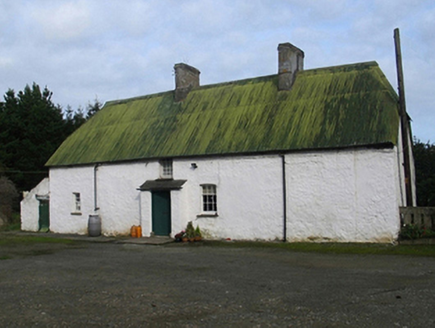Survey Data
Reg No
15703757
Rating
Regional
Categories of Special Interest
Architectural, Historical, Social
Original Use
Farm house
In Use As
Farm house
Date
1700 - 1793
Coordinates
300570, 124834
Date Recorded
21/01/2008
Date Updated
--/--/--
Description
Detached three-bay single-storey lobby entry thatched farmhouse with half-dormer attic, extant 1793, on a T-shaped plan off-centred on single-bay single-storey lean-to windbreak. For sale, 2006. Corrugated-iron covered hipped or hipped gabled oat thatch roof on collared timber construction with pressed iron ridge, rendered buttressed chimney stacks having stringcourses below capping, and cast-iron rainwater goods on limewashed eaves retaining cast-iron downpipes. Limewashed lime rendered battered walls. Square-headed off-central door opening with concrete threshold, and concealed dressings including timber lintel framing timber boarded or tongue-and-groove timber panelled door. Square-headed window openings with shallow sills, and concealed dressings framing six-over-six (north) or three-over-six (south) timber sash windows having part exposed sash boxes. Square-headed window openings (side elevations) with shallow sills, and concealed dressings framing six-over-six timber sash windows having part exposed sash boxes. Set in courtyard.
Appraisal
A farmhouse identified as an important component of the eighteenth-century vernacular heritage of County Wexford by such attributes as the rectilinear lobby entry plan form off-centred on a characteristic windbreak; the construction in unrefined local materials displaying a battered silhouette with sections of "daub" or mud suggested by an entry in the "House and Building Return" Form of the National Census (NA 1901; NA 1911); the pronounced disproportionate bias of solid to void in the massing; and the high pitched roof showing a protected oat thatch finish (cf. cf. 15700723; 15701608; 15702208; 15702220; 15703326; 15703330; 15703753; 15704107). A prolonged period of unoccupancy notwithstanding, the elementary form and massing survive intact together with substantial quantities of the original fabric, both to the exterior and to the interior, thus upholding the character or integrity of the composition. Furthermore, adjacent "tin roofed" outbuildings (----) continue to contribute positively to the group and setting values of a self-contained ensemble having historic connections with John Hay (d. 1798) who was executed on Wexford Bridge for his participation in the 1798 Insurrection (cf. 15703249).

